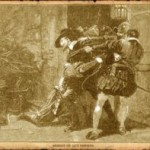The 5th of November – How History Makes Guy Fawkes More Than Fireworks
 The 5th of November
The 5th of November
How History Makes Guy Fawkes More Than Fireworks
By Sjirk Bajema
[The Rev. Sjirk Bajema has served as the minister of the Reformed Church of Mangere, Auckland, New Zealand for the past ten years and also as the Editor of the denominational magazine, “Faith in Focus”, for the last eight years. (This magazine may be viewed online at www.rcnz.org.nz .) Starting in January 2009, the Rev. Bajema will serve as the minister of the Presbyterian Church of Eastern Australia in Narre Warren, Melbourne, God willing. Both of these denominations are members of the International Conference of Reformed Churches.]
Guy Fawkes – we all know about it! For that certain time every year there are those fireworks that fill the air. The Fire Service is a lot busier, politicians make the same old rumblings about threatening to ban it, and it drives the pets crazy.
But what do you actually know about Guy Fawkes – especially the person? Perhaps you’re thinking: “Didn’t he try to blow up Parliament?” You may have the popular image of him – he was a somewhat foolish man who got caught doing something that could never have possibly succeeded. That’s why children in the past have made those “guys” – the old clothes stuffed with straw to make a dummy – that were placed on wheelbarrows and wheeled around the streets to collect coins for the fireworks let off when the “guy” was burned on top of the bonfire. “Penny for a guy,” the kids used to sing out.
The 5th of November is therefore just an excuse for fireworks. Isn’t it? Well, if it was you can be sure the government would have banned it by now. It’s actually because the original event the day is based on was a very serious threat to the English Royal family and the whole English Parliament that it has become that annual event on the calendar.
Let’s then see what happened. And so we will see how important the failure of this plot was to the Protestant cause in England.
.
The Personal Details
Guy Fawkes was born on the 13 April 1570, in Stonegate, Yorkshire, England. His father was a lawyer – a notary of the ecclesiastical courts and advocate of the consistory court of the Archbishop of York. On his mother’s side there was a long line of eminent merchants of Aldermen of York. While initially raised as a Protestant, upon his father’s death when he was 7 years old, and his mother’s subsequent marriage to a dedicated Roman Catholic, he was sent to a school with known Romanist sympathies and several of his fellow students were later numbered amongst the same. One of these was a Christopher Wright.
This direction in religious leanings was subsequently confirmed through Fawkes becoming briefly a footman to the 2nd Lord Montague, a member of a leading pro-Romanist family.
.
A Dutch Connection
What happens next is something that brings home this story to many of our own stories, as it relates to those of a Dutch heritage. Guy Fawkes, following his Catholic fanaticism, joined the armies of Spain in fighting against the United Protestant Provinces of the Netherlands. This was the famous “Eighty Year War” that is indelibly impressed on Dutch history. Just as we would be well aware of the English Protestants who fought for the Dutch Protestants, so there were also a number who willingly joined the other side for religious reasons.
Guy Fawkes fought for ten years under the flag of Philip II of Spain. By the time the forces of Philip captured Calais in 1596, he held a post of command. He was described at this time as a man “of excellent good natural parts, very resolute and universally learned”, and was “sought by the most distinguished in the Archduke’s camp for nobility and virtue.” He was certainly known for his deep commitment to the cause of Rome. It was also noted that during this time he became somewhat of a specialist in the use of explosives.
It seems his character brought him to the attention of Sir William Stanley, who was in charge of the English regiment in Flanders, and to Hugh Owen and Father William Baldwin – key Roman Catholic leaders in the struggle against Protestantism in England. In 1603 the connection between Fawkes and these men resulted in him going to Spain to speak with Philip II regarding the situation of the Romanists in England. At this time he met up again with Christopher Wright and they endeavoured to gain Spanish support for an invasion of England upon the death of Elizabeth I. That, of course, didn’t happen, but it certainly didn’t stop Fawkes seeking out further opportunities to destabilise the English authorities.
The Plot Itself
Returning to Brussels, Fawkes met up with a Thomas Wintour, and then was invited by Robert Catesby to accompany Wintour back to England as part of a diplomatic mission. The plot thickened in London in May 1604 at the notorious meeting in the Duck and Drake inn. There, three others joined the “gunpowder conspiracy”. The seriousness of this was indicated by the oath taken by all members of the group – an oath then sanctified by the performing of mass and the administering of the sacraments by the Jesuit priest John Gerard in an adjoining room. It seems Fawkes was a particularly valuable person in this plot as he was relatively unknown as a recusant in England. He assumed the identity of John Johnson, a servant of one of the co-conspirators, and was given control of the basement rooms from which they were endeavouring to dig a tunnel to go under Parliament. This work proved far too cumbersome and so the conspirators turned to hiring a cellar below Parliament.
Into this room Fawkes, with some of the others, began bringing barrels of powder, hidden below iron bars and faggots (which were balls of seasoned chopped liver). By March 1605, they had hidden 1800 pounds (36 barrels, or 800kgs) of gunpowder in the cellar. This would have been more than enough to blow Parliament into many pieces! The timing of the explosion was planned for a time when the whole of Parliament would be sitting with the king and his son, the heir to the throne, present.
Its Failure
The plan fell apart, however, when one of the conspirators wrote a warning letter to a leading Roman Catholic nobleman, alluding to what was to happen, though in an oblique way. He was William Parker, the 4th Baron Monteagle. He was not at all pleased with the idea, so he sent the letter directly to the Secretary of State, who initiated a search of the vaults beneath the House of Lords in the early hours of 5th of November.
Guy Fawkes was found in the cellar together with the incriminating evidence of a watch, slow matches, and touchwood. He was immediately arrested and for some days subjected to extensive torture. He held back at first from declaring who the co-conspirators were but named them on the 9 November after hearing that some had been subsequently arrested for another offence.
In late January 1606, the trial of eight alleged conspirators was held. It resulted in the guilty verdict for all of them and they all suffered the same death by hanging on the last day of the month.
How This Was Remembered In Subsequent History
It’s a very instructive lesson as to the tension of the time with the way the event was remembered immediately afterwards. A comparable fear in our society today as to how the Romanist threat was seen then would be the Muslim terrorist. It is no wonder that a number of contemporary verses were written clearly condemning Guy Fawkes. One of these goes:
.
Remember, remember, the fifth of November,
The gunpowder, treason, and plot,
I know of no reason
Why gunpowder treason
Should ever be forgot.
.
Other verses had a strong religious theme. They celebrated the rescue of the nation from an evil conspiracy. A John Wilson in 1612, writing in this vein, said:
.
O England praise the name of God
That kept thee from this heavy rod!
But though this demon e’er be gone,
His evil now be ours upon!
.
Later John Milton based his Satan in book 6 of Paradise Lost on Fawkes. There the devil is pictured as inventing gunpowder to try to match God’s thunderbolts. Later writing continued in similar vein so that Guy Fawkes virtually became the devil incarnate.
Every year for many years afterwards it was remembered on the date of the 5th of November through sermons preached in churches which patriotic citizens sponsored. Just as the American President, post 9-11, wears the flag badge, this commemoration became a flag-flying exercise.
.
For Us Today?
Obvious patriotism aside, we too should be thankful that this plot failed. If it had succeeded and England been thrown into turmoil, it could well have spelled the end of the Protestant movement in that country. The so-called middle-way of Anglicanism would have taken a huge battering. There would certainly have been no King James Version of the Bible, and the increasing expression of puritan thoughts could well have been repressed.
.
Chronology of English Monarchs
Henry VIII (broke with Rome though retained tendencies) 1509-47
Edward VI (Protestant with reformed tendencies) 1547-53
Mary (strongly Roman Catholic) 1553-58
Elizabeth I (Anglican settlement) 1558-1603
James I (continued Anglican settlement, High Church) 1604-25
.
Comments are closed for this Article !




